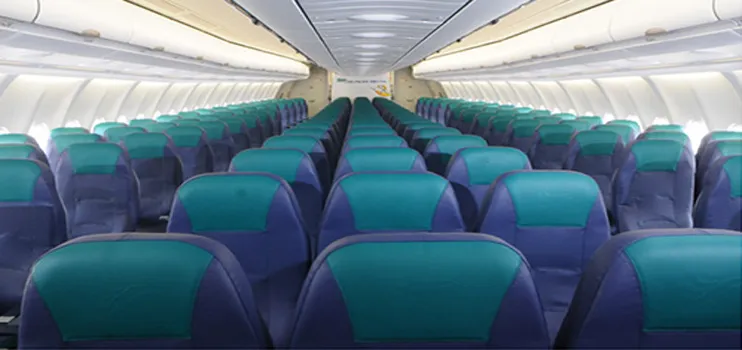
Cebu Pacific presents the world's most cramped long haul A330
Aug 12, 2014

Cebu Pacific has gained attention for operating what is considered the world's most cramped long-haul A330. With a high-density seating configuration, the airline maximizes capacity by fitting more seats than typical for this aircraft type. Passengers can expect limited legroom and narrow aisles, which may lead to discomfort during extended flights. Despite the tight quarters, Cebu Pacific aims to provide affordable travel options, making long-distance journeys accessible to budget-conscious travelers. The airline's unique approach reflects its commitment to efficiency but raises questions about passenger comfort and overall flying experience on longer routes.
When it comes to air travel, comfort is often a major concern for passengers, especially on long-haul flights. Cebu Pacific, a prominent low-cost airline in the Philippines, has made headlines with its recent announcement regarding the A330 aircraft configuration. This article will delve into the details of what makes Cebu Pacific’s A330 the world's most cramped long-haul aircraft, providing insights into its seating arrangement, passenger experience, and the implications for travelers.
The A330 Configuration
Cebu Pacific's A330 has been configured to maximize capacity at the expense of personal space. The airline has opted for a high-density seating layout that accommodates more passengers than most other airlines. The seating arrangement typically features:
| Seating Class | Seat Configuration | Total Seats |
|---|---|---|
| Economy Class | 3-3-3 | 440 |
| Business Class | 2-2-2 | 24 |
This configuration results in a significantly higher number of seats compared to standard A330 layouts, making it one of the most densely packed aircraft in the skies.
Passenger Experience
Travelers flying with Cebu Pacific's A330 should prepare themselves for a unique experience. With limited legroom and narrower seats, the lack of personal space can be challenging on long-haul flights. The airline has received mixed feedback from passengers regarding comfort levels. A few of the key aspects include:
- Legroom: The standard seat pitch can be as little as 28 inches, which is below the industry average. This can lead to discomfort, especially on flights exceeding several hours.
- Seat Width: The seats are designed to accommodate more passengers, resulting in narrower seating that may feel cramped for larger individuals.
- In-flight Amenities: While Cebu Pacific offers basic in-flight services, amenities such as personal entertainment screens may not be available on all flights, leaving passengers reliant on their devices for entertainment.
Cost vs. Comfort
One of the primary reasons passengers choose Cebu Pacific is the affordability of their tickets. The airline positions itself as a budget carrier, providing competitive pricing that attracts price-sensitive travelers. However, this comes with trade-offs in terms of comfort and service. The choice is often between a lower fare and a more cramped flying experience. Here are some considerations:
- Pricing: Cebu Pacific frequently offers promotional fares that can be incredibly appealing to travelers looking to save money.
- Additional Fees: While the initial ticket price may be low, additional fees for baggage, seat selection, and in-flight meals can add up.
Industry Implications
The emergence of cramped configurations like that of Cebu Pacific’s A330 may signal a shift in airline practices, especially among low-cost carriers. As airlines strive to increase profitability, the focus on maximizing passenger capacity often leads to tighter seating arrangements. This trend raises questions about:
- Passenger Health: Cramped seating can lead to discomfort and even health risks such as deep vein thrombosis (DVT) during long flights.
- Consumer Preferences: Will travelers continue to prioritize low fares over comfort? As more airlines adopt similar seating strategies, consumer responses will shape future configurations.
Chart: Comparison of A330 Configurations
Below is a comparison chart of various airlines' A330 configurations, highlighting Cebu Pacific's high-density seating arrangement:
| Airline | Economy Class Configuration | Total Economy Seats |
|---|---|---|
| Cebu Pacific | 3-3-3 | 440 |
| Qatar Airways | 2-4-2 | 276 |
| Singapore Airlines | 2-4-2 | 253 |
| Emirates | 3-3-3 | 400 |
This chart illustrates the stark contrast in passenger capacity and comfort levels across different airlines, emphasizing Cebu Pacific's position as a leader in high-density configurations.
Conclusion
Cebu Pacific's A330 has undoubtedly made its mark as the world's most cramped long-haul aircraft, offering an experience that prioritizes capacity over comfort. Passengers must weigh the trade-offs of low-cost travel against their personal comfort needs. As the aviation industry evolves, it remains to be seen how consumer preferences will influence seating configurations in the future. For now, travelers should prepare for a unique journey aboard Cebu Pacific’s A330, where adventure awaits, albeit in a tight space.
Related Articles

Explore Thailand: The Best Islands to Visit for Paradise, Adventure, and Relaxation

The Ultimate Guide to the Best Islands in Thailand for Your Next Getaway

Do babies need passports? How to get a passport for a newborn

How to get a U.S. passport fast: here’s how to expedite the process

What is Mobile Passport Control: 5 reasons why you should use it

SENTRI vs. Global Entry: A detailed guide

Do you need a passport to go to the Bahamas? Let’s find out

Do you need a passport to go to Mexico? A detailed guide

Do you need a passport to go to Canada? We got the answer

Do You Need a Passport for a Cruise: An Essential Travel Guide

Booster Seat Requirements: All the Rules to Follow in Your Rental Car

What Are the World’s Most Powerful Passports, and How Does Yours Rank?

How to Take a Passport Photo at Home: A Helpful Guide

You've got to have heart! Southwest's new livery

Your opinion: Should water be free on low cost carriers?

Young women bolder than guys as solo travellers
